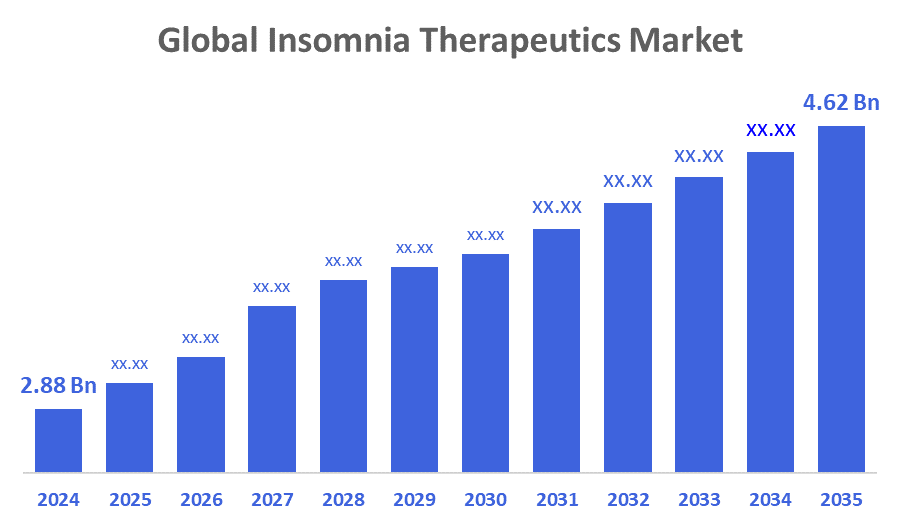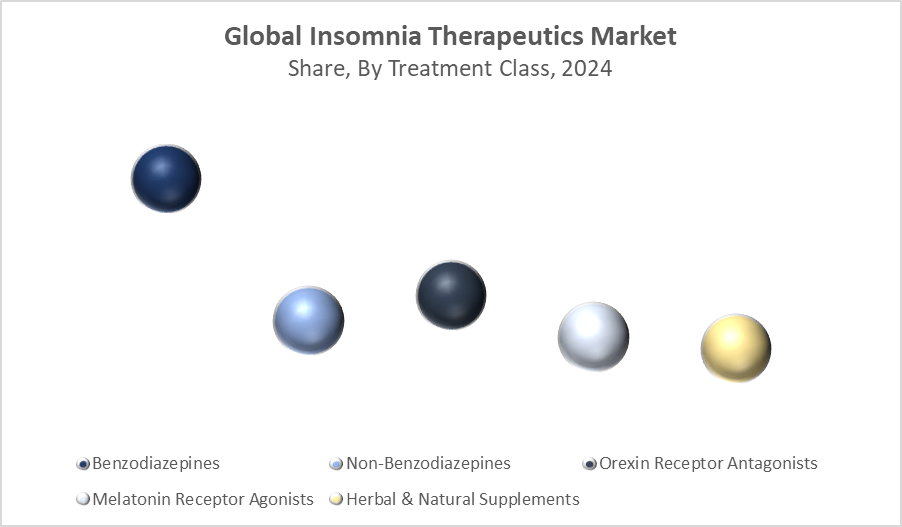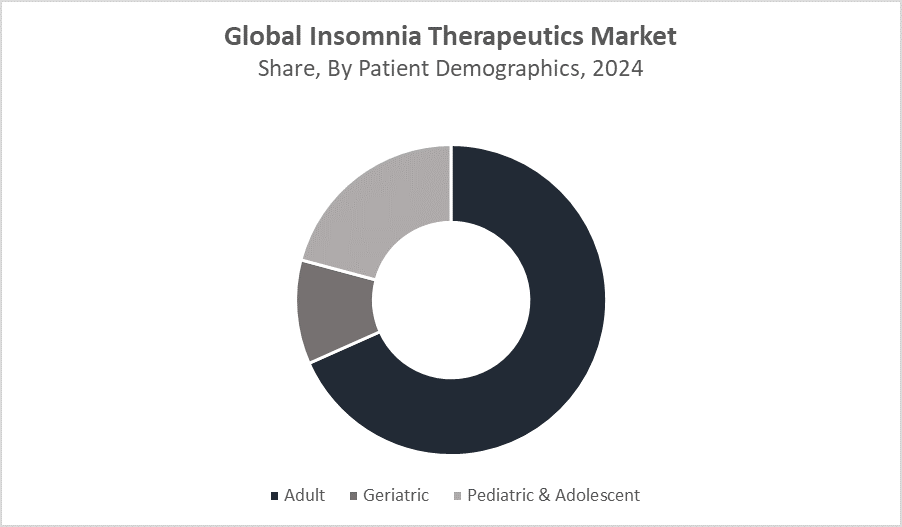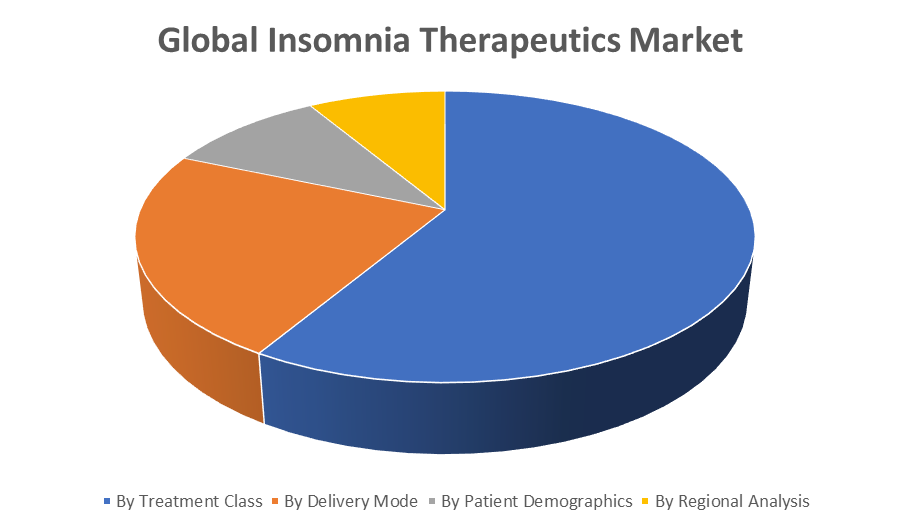Global Insomnia Therapeutics Market
Global Insomnia Therapeutics Market Size, Share, and COVID-19 Impact Analysis, Impact of Tariff and Trade War Analysis, By Treatment Class (Benzodiazepines, Non-Benzodiazepines, Orexin Receptor Antagonists, Melatonin Receptor Agonists, and Herbal & Natural Supplements), By Delivery Mode (Oral Tablets & Capsules, Sublingual & Nasal Sprays, Injectable, and Digital Therapeutics), By Patient Demographics (Adult, Geriatric, and Pediatric & Adolescent), and By Region (North America, Europe, Asia-Pacific, Latin America, Middle East, and Africa), Analysis and Forecast 2025 - 2035
Report Overview
Table of Contents
Insomnia Therapeutics Market Summary, Size & Emerging Trends
According to Decisions Advisors, The Global Insomnia Therapeutics Market Size is expected to Grow from USD 2.88 Billion in 2024 to USD 4.62 Billion by 2035, at a CAGR of 4.39% during the forecast period 2025-2035. Rising prevalence of sleep disorders, increasing mental health awareness, and growing adoption of both pharmacological and digital therapeutics drive market expansion.

Key Market Insights
- Rising insomnia prevalence worldwide, driven by stress, lifestyle changes, and aging populations, boosts demand for effective treatments.
- Orexin receptor antagonists are the fastest-growing drug segment due to improved safety and efficacy over traditional therapies.
- Behavioural therapies, especially digital cognitive behavioural therapy for insomnia (CBT-I), are gaining popularity as non-drug treatment options.
- North America dominates the market with advanced healthcare infrastructure and early adoption of innovative insomnia therapies.
Global Market Forecast and Revenue Outlook
- 2024 Market Size: USD 2.88 Billion
- 2035 Projected Market Size: USD 4.62 Billion
- CAGR (2025-2035): 4.39%
- North America: Largest market in 2024
- Asia Pacific: Fastest growing market
Insomnia Therapeutics Market
The insomnia therapeutics market addresses both chronic and acute insomnia using pharmacological and behavioural treatments. Traditional drugs like benzodiazepines and non-benzodiazepines have been widely used, but newer options such as orexin receptor antagonists and melatonin receptor agonists are gaining traction due to better safety and effectiveness. Behavioural therapies, particularly cognitive behavioural therapy for insomnia (CBT-I), are becoming more popular, especially through digital platforms that improve accessibility and adherence. The market is expanding as sleep disorders increase globally, driven by lifestyle changes, ageing populations, and growing awareness of mental health. Additionally, government programs focused on mental wellness and enhanced healthcare infrastructure contribute to market growth. This combination of innovative therapies and supportive policies positions the insomnia therapeutics market for steady advancement in the coming years.
Insomnia Therapeutics Market Trends
- Increasing preference for non-addictive therapies like orexin receptor antagonists and digital CBT platforms.
- Growing adoption of combination therapies integrating pharmacological and behavioral approaches.
- Expansion of telehealth and mobile app-based insomnia management.
- Rising consumer inclination towards herbal and natural supplements for mild insomnia.
Insomnia Therapeutics Market Dynamics
Driving Factors: Advances in pharmacological research have led to safer and more effective drugs
The global rise in insomnia cases, driven by increasing stress, hectic lifestyles, and ageing populations, significantly fuels demand for effective treatments. Advances in pharmacological research have led to safer and more effective drugs, attracting more patients. Additionally, digital therapeutics, such as app-based cognitive behavioural therapy (CBT), improve treatment accessibility and adherence. Rising healthcare spending, alongside growing awareness about mental health, encourages patients to seek help and supports market expansion. Together, these factors create a favourable environment for the insomnia therapeutics market to grow steadily worldwide.
Restrain Factors: Many insomnia medications carry risks of side effects and dependency
The market faces several challenges restricting its growth. Many insomnia medications carry risks of side effects and dependency, leading to patient reluctance. Regulatory hurdles for approving digital therapeutics slow down their market introduction. Behavioural treatments require consistent patient commitment, often resulting in low adherence rates. Moreover, pricing issues and limited insurance coverage, particularly in emerging economies, make therapies less accessible. These factors combine to hinder overall market growth despite rising demand.
Opportunity: Integrative treatment models combining drug therapy with behavioural interventions also provide attractive options
Emerging markets in the Asia Pacific and Latin America offer strong growth potential due to improving healthcare infrastructure and rising insomnia diagnosis rates. Innovation in personalised medicine, such as tailored pharmacological regimens and AI-powered digital CBT platforms, holds promise for enhancing treatment outcomes. Integrative treatment models combining drug therapy with behavioural interventions also provide attractive options. Collaborations between pharmaceutical companies and technology firms can accelerate the development and distribution of advanced insomnia treatments, opening new revenue streams and expanding patient reach in these fast-growing regions.
Challenges: Data privacy concerns related to digital therapies and patient information security may limit adoption
The insomnia therapeutics market is challenged by strict regulatory approval processes, which can delay the launch of new treatments and digital platforms. Data privacy concerns related to digital therapies and patient information security may limit adoption. Additionally, competition from widely available over-the-counter remedies offers patients less expensive alternatives. Supply chain issues affecting raw materials for drug manufacturing and a shortage of trained professionals to deliver behavioral therapies further impede market progress. These obstacles necessitate strategic solutions to ensure sustainable growth in this competitive market.
Global Insomnia Therapeutics Market Ecosystem Analysis
The ecosystem includes pharmaceutical companies developing pharmacological treatments, digital health companies creating CBT and app-based therapies, healthcare providers, pharmacies, and regulatory bodies. Key collaborations among these stakeholders aim to enhance treatment efficacy and accessibility. The rise of telemedicine and e-commerce platforms shapes the distribution landscape, while growing patient advocacy influences treatment innovation.
Global Insomnia Therapeutics Market, By Treatment Class
Benzodiazepines have traditionally been a widely used class of drugs for treating insomnia, accounting for about 45% of the insomnia therapeutics market share. However, their popularity is declining due to well-known side effects such as drowsiness, cognitive impairment, and the risk of dependency and withdrawal symptoms. These safety concerns have led healthcare providers and patients to seek safer alternatives, contributing to a gradual decrease in benzodiazepine usage in favor of newer therapies.

Orexin receptor antagonists represent a fast-growing segment, currently holding approximately 25% of the market share. This growth is driven by their improved efficacy and better tolerability profiles compared to traditional drugs. They work by targeting wakefulness-promoting pathways, helping patients achieve more natural sleep cycles without the typical side effects linked to benzodiazepines. Increasing clinical adoption and positive patient outcomes are expected to boost this segment further during the forecast period.
Global Insomnia Therapeutics Market, By Delivery Mode
Oral tablets and capsules are the dominant mode of delivery in the insomnia therapeutics market, accounting for about 70% of the market share. They are preferred for their convenience, ease of use, and suitability for chronic treatment regimens. This traditional format allows for consistent dosing and widespread acceptance among patients and healthcare providers, making it the most common choice for managing both acute and chronic insomnia.
Sublingual and nasal sprays are an emerging segment, currently holding around 15% of the market share. These delivery forms are gaining popularity due to their faster onset of action, providing quicker relief for patients experiencing acute insomnia symptoms. Their ease of administration and rapid absorption make them attractive alternatives, especially for patients seeking prompt sleep induction. This segment is expected to grow as more products gain regulatory approval and market acceptance.
Global Insomnia Therapeutics Market, By Patient Demographics
The adult segment, comprising individuals aged 18 to 64 years, is the largest in the global insomnia therapeutics market, accounting for approximately 75% of the market share. This dominance is driven by factors such as high work-related stress, fast-paced lifestyles, and increasing mental health awareness among working-age adults. The widespread prevalence of insomnia in this group fuels demand for both pharmacological and behavioral therapies, making it the primary focus for treatment development and marketing.

The pediatric and adolescent segment holds a smaller but steadily growing share of about 25%. This growth is largely due to increasing recognition of sleep disorders in younger populations and a stronger emphasis on non-pharmacological, behavioral treatments like cognitive behavioral therapy tailored for children and teens. Awareness campaigns and pediatric healthcare improvements contribute to the rising adoption of insomnia therapeutics in this demographic.
North America leads the global insomnia therapeutics market,
Primarily due to its advanced healthcare infrastructure, high prevalence of sleep disorders, and strong adoption of innovative therapies. The region benefits from widespread awareness about mental health, significant R&D investments, and favourable reimbursement policies. The U.S., in particular, accounts for the majority share, supported by the availability of both pharmacological and behavioural treatments. Additionally, the presence of leading pharmaceutical and digital health companies accelerates product innovation and market penetration.
The United States dominates the insomnia therapeutics market in North America,
Accounting for the majority share in the region. High prevalence of insomnia, affecting an estimated 35% of adults, drives sustained demand for pharmacological treatments such as orexin receptor antagonists, benzodiazepines, and melatonin receptor agonists. The U.S. also leads in the adoption of digital cognitive behavioural therapy (CBT-I), supported by strong telehealth infrastructure and mental health awareness campaigns.
Asia Pacific is experiencing rapid growth in the insomnia therapeutics market,
Due to increasing healthcare investments, rising urban stress levels, and greater awareness of mental health issues. Countries like China, India, and Japan are expanding their digital health ecosystems, enabling broader access to behavioral therapies such as digital CBT. As diagnosis rates rise and sleep health becomes a public health priority, the region is expected to witness strong demand for both traditional medications and tech-enabled therapies, positioning it as a key future market for insomnia solutions.
WORLDWIDE TOP KEY PLAYERS IN THE INSOMNIA THERAPEUTICS MARKET INCLUDE
- Pfizer Inc.
- Merck & Co., Inc.
- Jazz Pharmaceuticals plc
- Eisai Co., Ltd.
- Novartis AG
- Teva Pharmaceutical Industries Ltd.
- Sanofi S.A.
- ResMed Inc. (Digital Therapeutics)
- Big Health, Inc. (Digital CBT)
- Amneal Pharmaceuticals LLC
- Others
Product Launches in Insomnia Therapeutics Market
- In March 2024, Pfizer launched a novel orexin receptor antagonist designed to treat chronic insomnia with a focus on enhanced safety and tolerability. This new therapy represents a significant advancement over traditional sedative-hypnotics, offering reduced risk of dependency, minimal next-day drowsiness, and improved sleep quality. The drug works by selectively targeting orexin receptors, which regulate wakefulness, thus helping patients fall and stay asleep more naturally.
Market Segment
This study forecasts revenue at global, regional, and country levels from 2020 to 2035. Decisions Advisors has segmented the insomnia therapeutics market based on the below-mentioned segments:

Global Insomnia Therapeutics Market, By Treatment Class
- Benzodiazepines
- Non-Benzodiazepines
- Orexin Receptor Antagonists
- Melatonin Receptor Agonists
- Herbal & Natural Supplements
Global Insomnia Therapeutics Market, By Delivery Mode
- Oral Tablets & Capsules
- Sublingual & Nasal Sprays
- Injectable
- Digital Therapeutics
Global Insomnia Therapeutics Market, By Patient Demographics
- Adult
- Geriatric
- Pediatric & Adolescent
Global Insomnia Therapeutics Market, By Regional Analysis
- North America
- US
- Canada
- Mexico
- Europe
- Germany
- UK
- France
- Italy
- Spain
- Russia
- Rest of Europe
- Asia Pacific
- China
- Japan
- India
- South Korea
- Australia
- Rest of Asia Pacific
- South America
- Brazil
- Argentina
- Rest of South America
- Middle East & Africa
- UAE
- Saudi Arabia
- Qatar
- South Africa
- Rest of the Middle East & Africa
Check Licence
Choose the plan that fits you best: Single User, Multi-User, or Enterprise solutions tailored for your needs.
We Have You Covered
- 24/7 Analyst Support
- Clients Across the Globe
- Tailored Insights
- Technology Tracking
- Competitive Intelligence
- Custom Research
- Syndicated Market Studies
- Market Overview
- Market Segmentation
- Growth Drivers
- Market Opportunities
- Regulatory Insights
- Innovation & Sustainability
Report Details
| Pages | 258 |
| Delivery | PDF & Excel via Email |
| Language | English |
| Release | Sep 2025 |
| Access | Download from this page |
